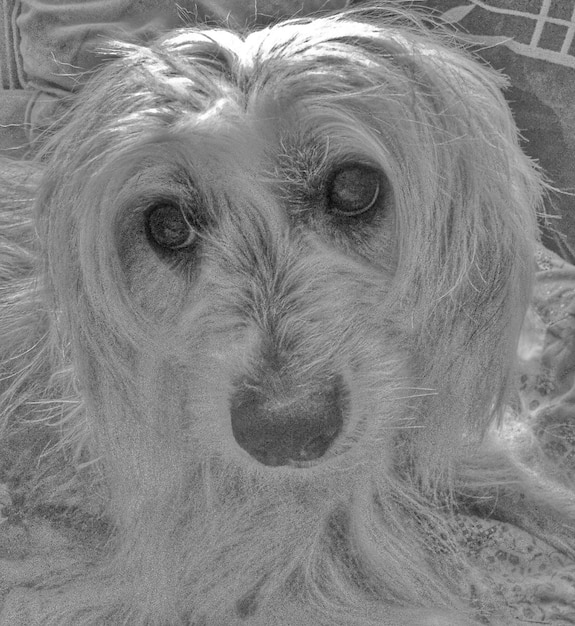Understanding Canine Cognitive Dysfunction: Early Detection and Management

Anúncios
Understanding Canine Cognitive Dysfunction (CCD), often referred to as dog dementia, involves recognizing early signs like disorientation and implementing management strategies to enhance the quality of life for aging dogs.
Do you notice your senior dog acting a little…different? Perhaps more confused, less responsive, or experiencing changes in their sleep patterns? It could be Canine Cognitive Dysfunction. Let’s delve into understanding Canine Cognitive Dysfunction: Early Detection and Management Strategies to help our beloved companions navigate their golden years with grace.
Anúncios
What is Canine Cognitive Dysfunction?
Canine Cognitive Dysfunction (CCD) is a neurodegenerative disease that affects senior dogs, often referred to as dog dementia or canine Alzheimer’s. It’s fundamentally similar to Alzheimer’s disease in humans, impacting cognitive functions such as memory, learning, and awareness.
As dogs age, their brains can undergo changes that lead to a decline in cognitive abilities. While some cognitive decline is a normal part of aging, CCD represents a more significant and accelerated deterioration.
Anúncios

Common Symptoms of CCD
Recognizing the symptoms of CCD is critical for early detection and intervention. The acronym DISHA can prove helpful, each letters corresponding to the major categories of cognitive decline:
- D – Disorientation: Dogs might get lost in familiar places, wander aimlessly, or seem confused about their surroundings.
- I – Interaction Changes: Changes can occur in how they interact with family members or other pets. A dog who was once friendly might become irritable, or vice versa.
- S – Sleep-Wake Cycle Disturbances: Disrupted sleep patterns, such as sleeping more during the day and being restless at night, are common.
- H – House Soiling: Even well-trained dogs might start having accidents indoors.
- A – Activity Level Alterations: Reduced interest in play, decreased exploration, or repetitive behaviors like pacing can be observed.
It’s important to note that these symptoms can also be indicative of other health issues. A vet must rule out other potential illnesses before diagnosing CCD.
In conclusion, CCD is a condition that can significantly impact the quality of life for senior dogs, so knowing its definition and common symptoms is vital for owners.
The Science Behind Canine Cognitive Dysfunction
The precise causes of Canine Cognitive Dysfunction are multifactorial, involving complex interactions between genetics, environmental factors, and the aging process. However, research has identified several key pathological changes in the brains of dogs with CCD.
Understanding the underlying mechanisms can help researchers develop targeted treatments and management strategies.
Key Pathological Changes
Several structural and chemical changes happen in the brains of dogs affected by CCD:
- Amyloid Plaques: Similar to Alzheimer’s disease in humans, amyloid plaques, which are abnormal protein deposits, accumulate in the brain. These plaques can disrupt normal neuronal function and lead to cell death.
- Neurofibrillary Tangles: These are twisted fibers made of the protein tau that accumulate inside brain cells. They disrupt the normal transport of nutrients and other essential substances within the cell, ultimately leading to neuronal dysfunction and death.
- Brain Atrophy: As dogs age, the overall volume of the brain can decrease, a process called atrophy. However, in dogs with CCD, brain atrophy appears to be accelerated, particularly in areas associated with cognitive functions, like the hippocampus.
Oxidative Stress and CCD
Oxidative stress occurs when there is an imbalance between the production of free radicals and the body’s ability to neutralize them with antioxidants. This imbalance can cause damage to cells and tissues, contributing to the progression of diseases, and CCD is no exception.
The science behind CCD involves a complex interplay of factors that affect brain health. By understanding these mechanisms, researchers and veterinarians can develop more effective strategies to manage and mitigate the effects of CCD, enhancing the well-being of our aging canine companions.

Early Detection: Recognizing the Subtle Signs
One of the biggest challenges in managing Canine Cognitive Dysfunction is early detection. Oftentimes, the initial signs of CCD are subtle and can be easily dismissed as normal aging. However, recognizing these early signs is crucial for implementing management strategies that can slow the progression of the disease.
Since the earlier CCD is detected, the sooner interventions can be put into place, the better the outcome for our beloved dogs.
Behavioral Changes to Watch For
Pay close attention to any changes in your dog’s behavior. While these changes might seem minor at first, they can be indicative of underlying cognitive issues:
- Changes in Sleep Patterns: Is your dog suddenly more restless at night or sleeping more during the day? A disruption in their sleep-wake cycle can indicate cognitive decline.
- Increased Anxiety or Irritability: A dog that used to be calm might become anxious or easily agitated. They might also become more irritable towards other pets or family members.
- Decreased Interest in Play: A noticeable decrease in enthusiasm for activities they once enjoyed can be a sign. This could include a lack of interest in walks, toys or social interaction.
- Repetitive Behaviors: Some dogs with CCD exhibit repetitive behaviors like pacing, licking, or barking without apparent reason. These behaviors can be indicators of increased anxiety and confusion.
Early detection of Canine Cognitive Dysfunction relies on observant owners who are familiar with their dog’s normal behavior. Recognizing even subtle deviations from this normal behavior can prompt veterinary intervention.
In conclusion, paying close attention to behavioral changes and consulting with your veterinarian at the first sign of cognitive issues can make a significant difference in the quality of life for your aging dog.
Medical Management and Treatment Options
While there is currently no cure for Canine Cognitive Dysfunction, several medical management and treatment options can help manage the symptoms and improve the quality of life for dogs affected by the disease.
A combination of medication, dietary adjustments, and environmental modifications can provide the best support for dogs with CCD.
Medications for CCD
Certain medications may help treat CCD:
- Selegiline: This monoamine oxidase B (MAO-B) inhibitor is one of the most commonly prescribed medications for CCD. It works by increasing dopamine levels in the brain, which can improve cognitive function and reduce some of the symptoms of CCD.
- Propentofylline: This medication improves blood flow to the brain and has neuroprotective effects. It can help improve alertness and cognitive function in dogs with CCD.
Dietary Adjustments
Changing a dog’s diet can also help, such as:
- Antioxidant-Rich Diet: Oxidative stress plays a significant role in the progression of CCD, so a diet rich in antioxidants can help protect brain cells from damage. Foods high in antioxidants include fruits, vegetables, and certain types of fish.
- Omega-3 Fatty Acids: Omega-3 fatty acids, particularly EPA and DHA, have been shown to have neuroprotective benefits. Supplementing your dog’s diet with fish oil can help support brain health.
Medical management of Canine Cognitive Dysfunction involves a multifaceted approach that combines medication, dietary adjustments, and lifestyle modifications. Remember to collaborate closely with your veterinarian to create a tailored plan, which is critical for optimizing the well-being of dogs with CCD.
Environmental Enrichment and Lifestyle Adjustments
In addition to medical treatments and dietary changes, environmental enrichment and lifestyle adjustments play a crucial role in managing Canine Cognitive Dysfunction. These strategies aim to provide mental stimulation, reduce stress, and maintain a sense of routine, which can help mitigate the symptoms of CCD.
Creating a stable, engaging, and stimulating environment can greatly improve the quality of life for dogs with CCD.
Creating a Supportive Environment
Making certain changes to the dog’s environment can have beneficial results:
- Maintain a Consistent Routine: Dogs with CCD benefit from a predictable routine. Regular feeding times, walks, and bedtime can provide a sense of security and reduce anxiety.
- Ensure Easy Access to Resources: Make sure your dog has easy access to food, water, and their bed. If your dog is having mobility issues, consider placing these resources on each level of the house.
- Provide Safe and Comfortable Bedding: A comfortable bed can provide a sense of security. Orthopedic beds are an excellent choice for aging dogs as they provide support and reduce joint pain.
Interactive Games and Training
Engaging in regular activities is important for stimulation:
- Puzzle Toys: Puzzle toys are a great way to provide mental stimulation. These toys require dogs to solve a problem to get a treat, which can help keep their minds engaged.
- Short Training Sessions: Short, positive reinforcement-based training sessions can help maintain cognitive function. Focus on simple commands and reward your dog for correct responses.
Environmental enrichment and lifestyle adjustments are essential components of managing Canine Cognitive Dysfunction. By creating a supportive and stimulating environment, owners can help mitigate the symptoms of CCD.
In conclusion, simple changes and interactive activities can make a significant difference in the comfort and cognitive well-being of senior dogs coping with cognitive decline.
Coping Strategies for Owners
Caring for a dog with Canine Cognitive Dysfunction can be physically and emotionally challenging. It’s important for owners to develop effective coping strategies to manage the stress and frustration that can arise. Remember that seeking support and understanding the nature of CCD can make the caregiving process more manageable.
Prioritizing self-care and seeking assistance when needed are essential for maintaining your well-being while caring for a dog with CCD.
Seeking Support and Education
Learning about the disease and reaching out to a support network is essential:
- Educate Yourself About CCD: Understanding the disease and its progression can help manage expectations and make informed decisions about your dog’s care.
- Join Support Groups: Connecting with other owners facing similar challenges can provide emotional support and practical advice. Online forums and local support groups can offer a sense of community.
Maintaining Your Well-Being
While caring for a dog with CCD, it’s easy to neglect your own needs. Remember that taking care of yourself is crucial for providing the best care for your dog.
- Take Breaks: Schedule regular breaks to recharge and de-stress. Even short periods away from caregiving responsibilities can make a big difference.
- Practice Self-Care: Engage in activities that bring you joy and relaxation, such as reading, exercising, or spending time with friends.
Caring for a dog with Canine Cognitive Dysfunction requires patience, understanding, and a proactive approach to both your dog’s and your own well-being. By seeking support, educating yourself, and prioritizing self-care, you can navigate the challenges of CCD and provide the best possible quality of life for your loyal companion.
In conclusion, finding healthy and proactive ways to cope with the demands of caregiving is paramount , ensuring both the dog’s well-being and the owner’s.
| Key Point | Brief Description |
|---|---|
| 🧠 Understanding CCD | CCD is a neurodegenerative disease, similar to Alzheimer’s, affecting senior dogs. |
| 🔍 Early Detection | Look for subtle changes like disorientation, sleep disturbances, or interaction changes. |
| 💊 Medical Management | Medications like selegiline can help manage symptoms; consult your vet. |
| 🏡 Environmental Adjustments | Maintain routine, ensure easy access to resources, and provide a safe environment. |
Frequently Asked Questions
▼
Early signs include disorientation, changes in interaction, sleep-wake cycle disturbances, house soiling, and activity level alterations. These can be subtle, so observe carefully.
▼
Diagnosis usually involves a physical exam, neurological assessment, and ruling out other medical conditions. Vets may use behavioral checklists to assess cognitive function.
▼
Yes, diets rich in antioxidants and omega-3 fatty acids can support brain health. Consult your vet for specific dietary recommendations tailored to your dog.
▼
Yes, medications like selegiline can help manage symptoms by increasing dopamine levels in the brain, improving cognitive function and reducing some behavioral issues.
▼
Maintain a consistent routine, provide mental stimulation with puzzle toys, ensure easy access to resources, and create a safe, comfortable environment. Love and patience are key.
Conclusion
Understanding Canine Cognitive Dysfunction is essential for providing compassionate care to our aging canine companions because recognizing early signs and implementing proper management strategies can significantly enhance their comfort and quality of life, making their golden years as fulfilling as possible.






